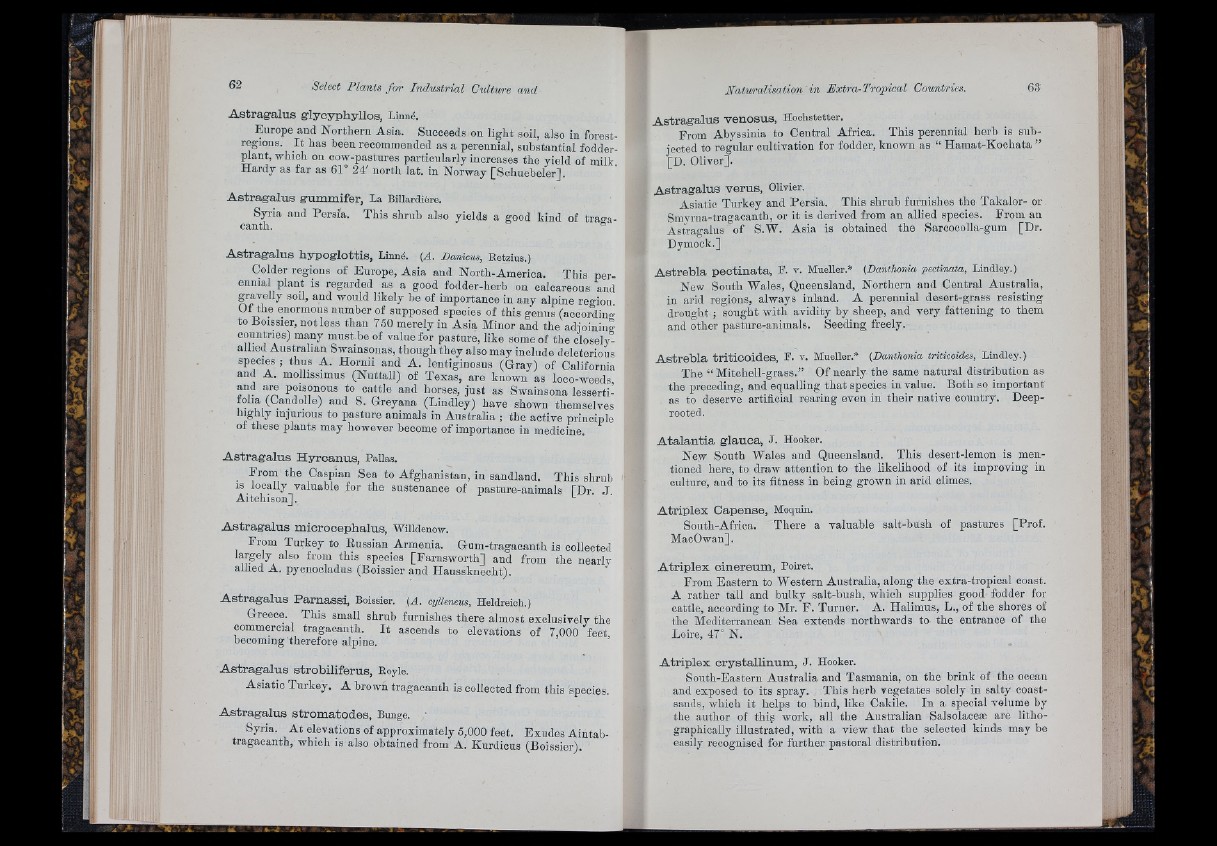
A s tr a g a lu s g ly c y p h y llo s , Linné.
Europe and Northern Asia. Succeeds on light soil, also in forest-
regions. E has been reoommended as a perennial, substantial fodder-
plant, which on eow-pastures particularly increases the yield of milk
Hardy as far as 61° 24' north lat. in Norway [Schuebeler],
A s tr a g a lu s g um m ife r, La Biliardière.
Syria and Persia. This shrub also yields a good kind of traga-
canth.
A s tr a g a lu s h y p o g lo ttis , Linné. (A. Panicus, Eetzius.)
Colder regions of Europe, Asia and North-America. This perennial
plant is regarded as a good fodder-herb on calcareous and
gravelly soil, and would likely be of importance in any alpine region
O fth e enormous number of supposed species of this genus (according
to Boissier, not less than 750 merely in Asia Minor and the adjoining
countries) many must be of value for pasture, like some of the closelyl
allied Australian Swainsonas, though they also may include deleterious
species ; thus A. Hornii and A. lentiginosus (Gray) of California
and A. mollissimus (Nuttall) of Texas, are known as loco-weeds,
and are poisonous to cattle and horses, ju st as Swainsona lesserti-
toiia (Candolle) aud S. Greyana (Lindley) have shown themselves
highly injurious to pasture animals in Australia ; the active principle
of these plants may however become of importance in medicine.
A s tr a g a lu s H y ro a n u s , Pallas.
_ From the Caspian Sea to Afghanistan, in sandland. This shrub
IS locally valuable for the sustenance of pasture-animals [Dr J
Aitchison].
A s tr a g a lu s m ic ro c e p h a lu s , Willdenow.
From Turkey to Russian Armenia. Gum-tragacantli is collected
largely also from this species [Farnsworth] and from the nearly
allied A. pycnocladus (Boissier and Haussknecht).
A s tr a g a lu s P a rn a s s i, Boissier. {A. cylleneus, Heldreich.)
Greece. This small shrub furnishes there almost exclusively the
commercial tragacanth. I t ascends to elevations of 7,000 feet
becoming therefore alpine. ’
A s tr a g a lu s s tro b ilif e ru s , Royle.
Asiatic Turkey. A brown tragacanth is collected from this species.
A s tr a g a lu s s trom a to d e s , Bunge. '
Syria. At elevations of approximately 5,000 feet. Exudes Aintab-
tragacanth, which is also obtained from A. Kurdicus (Boissier).
A s tr a g a lu s v e n o su s , Hochstetter.
From Abyssinia to Central Africa. This perennial herb is sub-
ected to regular cultivation for fodder, known as “ Hamat-Koohata ”
' ‘D. Oliver].
A s tr a g a lu s v e ru s , Olivier.
Asiatic Turkey and Persia. This shrub furnishes the Takalor- or
Smvrna-tragaoanth, or it is derived from an allied species. From an
Astragalus of S.W. Asia is obtained the Saroocolla-gum [Dr.
Dymock.]
A s tr e b la p e o tin a ta , F- V. Mueller.* (Danthonia 'pectinata, Lindley.)
New South Wales, Queensland, Northern and Central Australia,
in arid regions, always inland. A perennial desert-grass resisting
drought ; sought with avidity by sheep, and very fattening to them
and other pasture-animals. Seeding freely.
A s tr e b la tr itic o id e s , F. v. Mueller.* (Danthonia triticoides, Lindley.)
The “ Mitchell-grass.” Of nearly the same natural distribution as
the preceding, and equalling th a t species in value. Both so important
as to deserve artificial rearing even in their native country. Deep-
rooted.
A ta la n tia g lau o a , J. Hooker.
New South Wales and Queensland. This desert-lemon is mentioned
here, to draw attention to the likelihood of its improving in
culture, and to its fitness in being grown in arid climes.
A trip le x C ap en se , Moquin.
South-Africa. There a valuable salt-bush of pastures [Prof.
MacOwan].
A tr ip le x c in e re um , Poiret.
From Eastern to Western Australia, along the extra-tropical coast.
A rather tall and bulky salt-bush, which supplies good fodder for
cattle, according to Mr. F. Turner. A. Halimus, L., of the shores of
the Mediterranean Sea extends northwards to the entrance of the
Loire, 47° N.
A trip le x o ry s ta llin um , J. Hooker.
South-Eastern Australia and Tasmania, on the brink of the ocean
aud exposed to its spray. This herb vegetates solely in salty coast-
sands, which it helps to hind, like Cakile. In a special valume by
the author of this work, all the Australian Salsolacese are lithographically
illustrated, with a view th a t the selected kinds may be
easily recognised for further pastoral distribution.